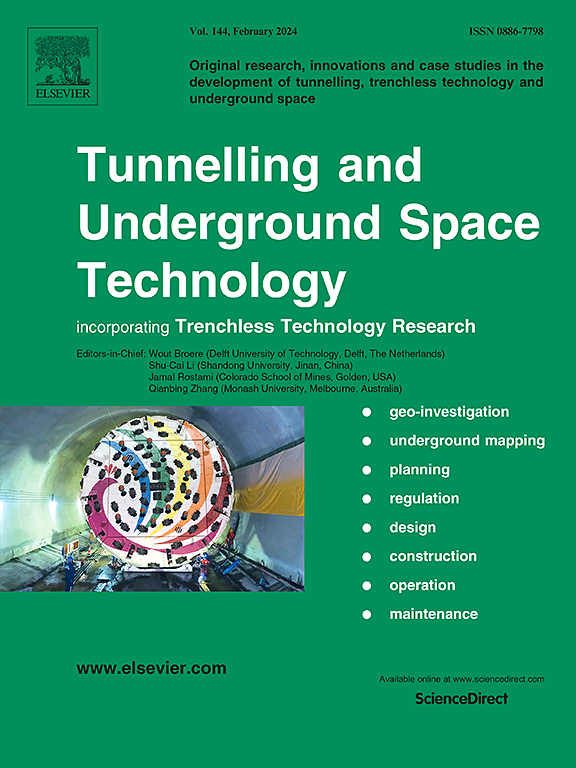A physics-guided hierarchical deep learning framework for underground rock reinforcement compliance check based on 4D point cloud data
IF 7.4
1区 工程技术
Q1 CONSTRUCTION & BUILDING TECHNOLOGY
引用次数: 0
Abstract
Rock bolts have been extensively used for rock reinforcement in underground mines. The compliance check for rock bolts installation pattern becomes significantly important for ensuring an optimal balance between the cost and performance of rock reinforcement. The current manual compliance check process requires tremendous manpower and inevitably introduces human errors and data bias issues. In order to address this challenge, in this study, a novel physics-guided hierarchical deep learning framework for underground rock reinforcement compliance check based on 4D point cloud data, termed PGHDFramework, was proposed. In this framework, a physics-based forward approach for bolt-level classification named Intensity-based Forward Classification (IBFC) model was introduced first, which requires no training process. Then a hierarchical deep neural network based on PointNet++ that can concatenate spatial information (i.e., x, y, z coordinates) and physical property information (i.e., intensity value) at different levels of abstraction, termed 4D Bolt Detection Neural Network (4DBDNet), was developed. The SLAM-LiDAR point cloud data from five sections of an underground mine with different conditions containing 25,146,657 points were used for validating the framework as well as comparing its performance with the existing methods. The precision, recall, F1 score and IoU of the proposed approach at point level are 0.92, 0.94, 0.93 and 0.73 separately, and at bolt-level are 0.60, 0.84, 0.70 respectively, showing a much higher promising performance than other methods. The accuracy and effectiveness of the proposed framework was further confirmed by compliance checking a fresh underground mine drive to autonomously generate the rock bolts spacing and row spacing. This study ultimately provides the framework of a universal-applicable digital approach to the mining industry for a more cost-effective and accurate rock reinforcement compliance check in practice.
基于四维点云数据的地下岩石加固符合性物理指导层次深度学习框架
锚杆在地下矿山岩体加固中得到了广泛的应用。锚杆安装方式的符合性校核对于确保岩石加固成本与性能之间的最佳平衡具有重要意义。当前的手动遵从性检查过程需要大量人力,并且不可避免地引入人为错误和数据偏差问题。为了解决这一挑战,本研究提出了一种新的基于四维点云数据的地下岩石加固符合性检查物理指导的分层深度学习框架,称为PGHDFramework。在此框架下,首先引入了一种不需要训练的基于物理的螺栓级前向分类方法——基于强度的前向分类(IBFC)模型。在此基础上,基于PointNet++开发了一种能够将不同抽象层次的空间信息(即x、y、z坐标)和物理属性信息(即强度值)连接起来的分层深度神经网络,称为4D螺栓检测神经网络(4DBDNet)。利用某地下矿山5个断面不同条件下的SLAM-LiDAR点云数据,共包含25,146,657个点,对该框架进行验证,并与现有方法进行性能比较。该方法在点水平上的准确率、召回率、F1分数和IoU分别为0.92、0.94、0.93和0.73,在螺栓水平上分别为0.60、0.84和0.70,表现出比其他方法更高的前景。通过对一个新的井下掘进机进行柔度校核,进一步验证了该框架的准确性和有效性。该研究最终为采矿业提供了一个普遍适用的数字方法框架,以便在实践中进行更经济、更准确的岩石加固符合性检查。
本文章由计算机程序翻译,如有差异,请以英文原文为准。
求助全文
约1分钟内获得全文
求助全文
来源期刊

Tunnelling and Underground Space Technology
工程技术-工程:土木
CiteScore
11.90
自引率
18.80%
发文量
454
审稿时长
10.8 months
期刊介绍:
Tunnelling and Underground Space Technology is an international journal which publishes authoritative articles encompassing the development of innovative uses of underground space and the results of high quality research into improved, more cost-effective techniques for the planning, geo-investigation, design, construction, operation and maintenance of underground and earth-sheltered structures. The journal provides an effective vehicle for the improved worldwide exchange of information on developments in underground technology - and the experience gained from its use - and is strongly committed to publishing papers on the interdisciplinary aspects of creating, planning, and regulating underground space.
 求助内容:
求助内容: 应助结果提醒方式:
应助结果提醒方式:


